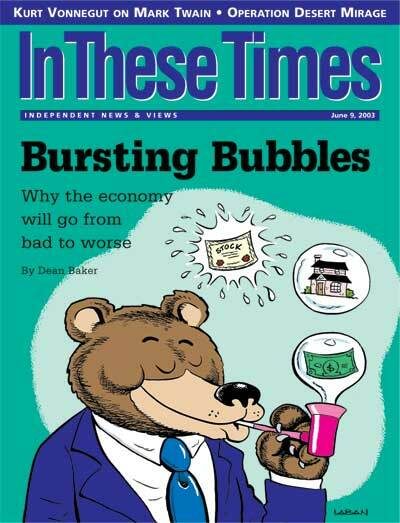As evidence of global warming mounts, the Bush administration and right-wing, industry-funded “researchers” who have long denied the phenomenon are trying a new tactic: muzzle the science.
In February, the Competitive Enterprise Institute, a pro-market think tank, asked the Bush administration to “cease dissemination” of a government report on grounds that it violates a new regulation, the Data Quality Act. The report, the National Assessment of Climate Change, modeled the likely impact of global warming on the United States. The unprecedented research effort took several years and involved government agencies, scientists and academics.
The Data Quality Act requires federal agencies to ensure the information they disseminate is accurate, and to enable interested parties—that is, industry—to challenge the information if they disagree. According to one high-ranking government official, who requested anonymity, the law—which was slipped into a 2001 appropriations bill without hearings—“could be used to undermine any legitimate scientific effort” that threatens corporate interests.
Burning fossil fuels releases carbon dioxide, the main culprit in planetary warming, into the atmosphere. The journal Science reports that energy consumption over the last 100 years has increased 16-fold, bumping atmospheric concentrations of carbon dioxide to their highest level in 420,000 years.
Acknowledging the existence of global warming threatens the fossil fuel industry, because mitigating or reversing it means shunning fossil fuels like coal and oil. Rather than deal with the problem, the powerful and hugely profitable fossil fuel industry has engaged in an aggressive disinformation campaign to discredit the science and disrupt any effort to solve it.
As higher levels of greenhouse gases trap heat in the Earth’s upper atmosphere, rising global temperatures are destabilizing climate patterns—thawing the permafrost in Alaska, melting glaciers, and causing enormous ice shelves to break apart in both the Arctic and Antarctica. The melting ice is expected to raise sea levels four to 40 inches by 2100, scientists say, submerging islands and coastal regions throughout the world. According to Robert Gagosian, director of the Woods Hole Oceanographic Institute, the influx of fresh water into the northern Atlantic Ocean could disrupt global ocean currents and potentially lead to a “mini ice age” in the northeastern United States and Europe, even as the rest of the planet warms.
Escalating weather-related disasters, which confirm computer-modeled predictions, are further discrediting the naysayers. And even the Bush administration now reluctantly admits global climate change is occurring as a result of burning fossil fuels.
That doesn’t mean they’re doing much about it. President Bush’s climate change plan, announced last year, has called for 10 more years of study and voluntary reductions of 18 percent in greenhouse gas intensity by 2012. The Kyoto Protocol, which Bush rejected, calls for 5 percent reductions from 1990 levels for industrialized nations by 2012. The United States, with 4 percent of the world’s population, is the largest contributor to global warming, releasing about 25 percent of the world’s greenhouse gases into the environment each year.
The environmental community dismisses the plan for voluntary reductions in greenhouse gas intensity as business as usual. Because the measures suggest decreases in the rate of growth of greenhouse gas emissions—rather than actual reductions—the policy on its own will actually increase greenhouse emissions 14 percent by 2012, says Dan Lashof, a climate scientist with the Natural Resources Defense Council.
Jerry Mahlman, a climate scientist with the National Center for Atmospheric Research, says scientists cannot predict exactly how much carbon in the atmosphere will tip off a catastrophic cascade of climate change, or what exactly the effects will be in any given region. But, he says, the future is here: Since carbon dioxide remains in the atmosphere for at least 100 years, past emissions have already committed the world to significant future climate change.
And censoring the science won’t make it go away.
In February, the Competitive Enterprise Institute, a pro-market think tank, asked the Bush administration to “cease dissemination” of a government report on grounds that it violates a new regulation, the Data Quality Act. The report, the National Assessment of Climate Change, modeled the likely impact of global warming on the United States. The unprecedented research effort took several years and involved government agencies, scientists and academics.
The Data Quality Act requires federal agencies to ensure the information they disseminate is accurate, and to enable interested parties—that is, industry—to challenge the information if they disagree. According to one high-ranking government official, who requested anonymity, the law—which was slipped into a 2001 appropriations bill without hearings—“could be used to undermine any legitimate scientific effort” that threatens corporate interests.
Burning fossil fuels releases carbon dioxide, the main culprit in planetary warming, into the atmosphere. The journal Science reports that energy consumption over the last 100 years has increased 16-fold, bumping atmospheric concentrations of carbon dioxide to their highest level in 420,000 years.
Acknowledging the existence of global warming threatens the fossil fuel industry, because mitigating or reversing it means shunning fossil fuels like coal and oil. Rather than deal with the problem, the powerful and hugely profitable fossil fuel industry has engaged in an aggressive disinformation campaign to discredit the science and disrupt any effort to solve it.
As higher levels of greenhouse gases trap heat in the Earth’s upper atmosphere, rising global temperatures are destabilizing climate patterns—thawing the permafrost in Alaska, melting glaciers, and causing enormous ice shelves to break apart in both the Arctic and Antarctica. The melting ice is expected to raise sea levels four to 40 inches by 2100, scientists say, submerging islands and coastal regions throughout the world. According to Robert Gagosian, director of the Woods Hole Oceanographic Institute, the influx of fresh water into the northern Atlantic Ocean could disrupt global ocean currents and potentially lead to a “mini ice age” in the northeastern United States and Europe, even as the rest of the planet warms.
Escalating weather-related disasters, which confirm computer-modeled predictions, are further discrediting the naysayers. And even the Bush administration now reluctantly admits global climate change is occurring as a result of burning fossil fuels.
That doesn’t mean they’re doing much about it. President Bush’s climate change plan, announced last year, has called for 10 more years of study and voluntary reductions of 18 percent in greenhouse gas intensity by 2012. The Kyoto Protocol, which Bush rejected, calls for 5 percent reductions from 1990 levels for industrialized nations by 2012. The United States, with 4 percent of the world’s population, is the largest contributor to global warming, releasing about 25 percent of the world’s greenhouse gases into the environment each year.
The environmental community dismisses the plan for voluntary reductions in greenhouse gas intensity as business as usual. Because the measures suggest decreases in the rate of growth of greenhouse gas emissions—rather than actual reductions—the policy on its own will actually increase greenhouse emissions 14 percent by 2012, says Dan Lashof, a climate scientist with the Natural Resources Defense Council.
Jerry Mahlman, a climate scientist with the National Center for Atmospheric Research, says scientists cannot predict exactly how much carbon in the atmosphere will tip off a catastrophic cascade of climate change, or what exactly the effects will be in any given region. But, he says, the future is here: Since carbon dioxide remains in the atmosphere for at least 100 years, past emissions have already committed the world to significant future climate change.
And censoring the science won’t make it go away.
Please consider supporting our work.

I hope you found this article important. Before you leave, I want to ask you to consider supporting our work with a donation. In These Times needs readers like you to help sustain our mission. We don’t depend on—or want—corporate advertising or deep-pocketed billionaires to fund our journalism. We’re supported by you, the reader, so we can focus on covering the issues that matter most to the progressive movement without fear or compromise.
Our work isn’t hidden behind a paywall because of people like you who support our journalism. We want to keep it that way. If you value the work we do and the movements we cover, please consider donating to In These Times.





